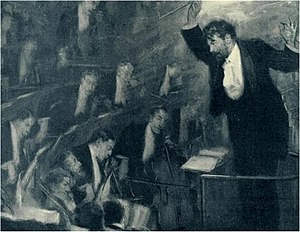You can access the data here. I have named the various string layouts according to conductors I strongly associate with them, as follows, as arranged left to right from the conductor's working point of view:
Adrian Boult* 1st Violins Cellos/Basses Violas 2nd Violins
Pierre Monteux 1st Violins Violas Cellos/Basses 2nd Violins
Henry Wood 1st Violins 2nd Violins Violas Cellos/Basses
Herbert von Karajan 1st Violins 2nd Violins Cellos/Basses Violas
Some Facts and Figures
Antiphonal violins featured in 38% of the concerts included in the study vs. 62% in which the first and second violins were seated together. Of the two antiphonal violin layouts, the 'Boult' was most often employed (16/22 concerts). Of the two violins together layouts, the 'Wood' was most often employed (28/36). This seems somehow appropriate considering that Wood and Boult were towering Proms figures in the first half of the 20th century.
 |
| Henry Wood in 1908 as painted by Cyrus Cuneo |
Of the twelve British conductors featured in the verified concerts, seven employed antiphonal violins. These were: Jonathan Nott, Donald Runnicles, Daniel Harding, Mark Elder, Robin Ticciati, Andrew Davis and Antonio Pappano.
All of the Wagner Operas were performed with antiphonal violins.
Of the thirteen orchestras performing with antiphonal violins, seven were British. Of the seventeen British orchestras performing, seven employed antiphonal violins some or all of the time.
Curiosities
Two conductors generally not associated with antiphonal violins employed them in at least one of their concerts: Andrew Davis and Marin Alsop. I daresay that they were respecting corporate layouts as I doubt the Orchestra of the Age of Enlightenment would be too happy about seating their violins together, particularly in the music of Schumann and Brahms. Also, the production of Billy Budd was part of a Glyndebourne tour and the orchestra was laid out this way for the tour, I believe.
Arch-antiphonalist, Valery Gergiev, opted for the 'Karajan' layout with the recently-formed National Youth Orchestra of the USA (Prom 13). Again, this may have been a corporate layout that Gergiev was respecting.
On two occasions, two conductors, François-Xavier Roth (Prom 4) and Sakari Oramo (Prom 52), opted to switch layouts halfway through concerts. This may have been due to the particular repertoire. Roth was certainly justified in employing the Monteux layout for the Rite of Spring, which was premiered by that late French conductor using that layout. Quite why he opted for the 'Karajan' layout in the French Baroque music I don't know. String layouts were changeable and frequently experimental in the Baroque period but I am not aware of this particular layout being employed from any of the schematic drawings I have seen. Oramo, a more recent convert to antiphonalism, likely employed the 'Wood' layout for the contemporary piece in the programme rather than for the Sibelius.
Violin seating flip-flopper, Mariss Jansons, presented the great Bavarian Radio Symphony Orchestra (Proms 33 and 35) in the 'Karajan' layout, which was introduced into orchestras long after the composers whose music was performed (Berlioz, Beethoven and Mahler) were dead. This was a disappointment, frankly, even if the concerts were not.
(Rafael Kubelik conducting the Bavarian Radio Symphony Orchestra in the 'Boult' layout)
Trends
This is the first year I have documented the layouts for the Proms and so I cannot comment on the difference between this year and last. However, I did take a keen interest in this matter last year and I'm pretty confident that there was a significant increase in the number of concerts featuring antiphonal violins. I will endeavour to conduct the same study next year so that a comparison can be made. The Proms is a unique music festival in that it features so many concerts and so many orchestras from around the world. It is, therefore, a useful indicator of trends in orchestral string seating.
I find the fact that more British conductors than not utilised antiphonal violins quite interesting, as well as the significant number of British orchestras deploying them. I think this represents a trend towards our orchestras restoring this layout more generally.
Please feel free to interrogate this data, modest in scale as it is.
@musicdirektor
*strictly speaking, Sir Adrian preferred his double basses to be ranged along the back of the orchestra.
No comments:
Post a Comment